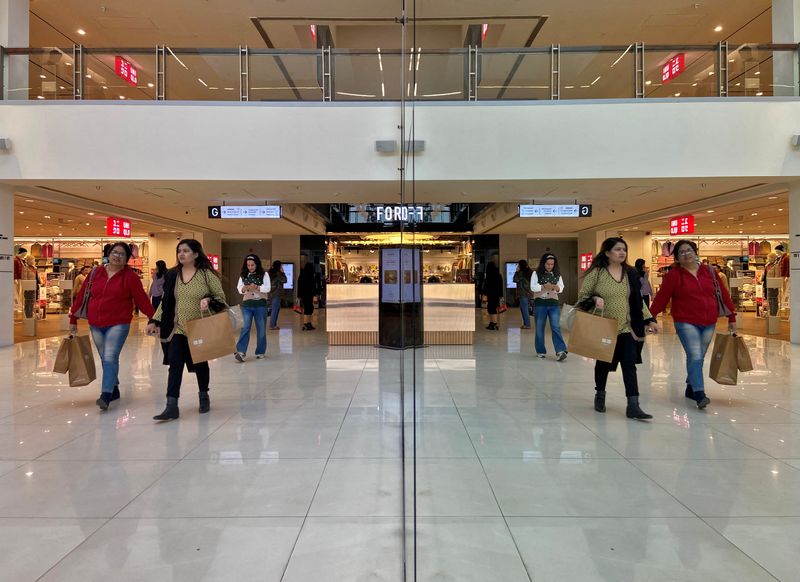By Praveen Paramasivam and Shivangi Acharya
CHENNAI/NEW DELHI – India’s metropolis dwellers are slicing spending on all the things from cookies to quick meals as persistently excessive inflation squeezes center class budgets, threatening the nation’s brisk financial development.
Slowing city spending over the previous three to 4 months has not solely damage the earnings of largest shopper items companies, it has raised questions in regards to the structural nature of India’s long-term financial success.
For the reason that finish of the pandemic, India’s financial development has been pushed largely by city consumption, nonetheless, that now appears to be altering.
“There is a top end – the people with money are spending like that is going out of style,” Nestle (NS:) India Chairman Suresh Narayanan mentioned.
“There used to be a middle segment, which used to be the segment that most of us fast moving consumer goods (FMCG) firms used to operate in, which is the middle class of the country, that seems to be shrinking.”
Nestle India, which makes Package Kats and different well-known items, reported its first quarterly income drop because the COVID-hit June quarter in 2020.
Whereas there isn’t a formally outlined earnings bracket for Indian center class households, they’re broadly estimated to account for a 3rd of India’s 1.4 billion individuals.
They’re thought of a key demographic each economically and politically, with center class frustration seen as a major issue behind Prime Minister Narendra Modi’s weaker election efficiency this yr.
Asia’s third-largest financial system is anticipated to broaden 7.2% within the monetary yr ending March 2025, the quickest amongst its main friends.
Belying these rosy projections, nonetheless, are indicators of a pointy slowdown within the family sector.
Indian city consumption hit a two-year low this month, in response to an index revealed by Citibank that captures indicators akin to airline bookings, gasoline gross sales and wages.
“While some of the fall could be temporary, the key macro drivers remain unfavourable,” Citi’s chief India economist Samiran Chakraborty mentioned.
Development in inflation-adjusted wage prices for listed Indian companies – a proxy for earnings of city Indians – has remained beneath 2% for all of the three quarters of 2024, properly beneath the 10-year common of 4.4%, information from Citi confirmed.
Chakraborty cites this as a key issue impacting city consumption, together with declining financial savings and tighter guidelines for private loans.
Headline inflation has averaged 5% over the previous 12 months, however meals inflation has held above 8% as climate shocks elevated costs of greens, cereals and different important meals. In October, retail inflation hit a 14-month excessive of 6.2% whereas meals costs jumped to 10.9%.
Anecdotal information suggests retail gross sales rose shut to fifteen% year-on-year through the 2024 festive season, which runs from August to November, Nomura mentioned in a word final week, about half final yr’s tempo.
“During this festival season, we have not spent at all,” mentioned Rajwanti Dahiya, 60, who survives on her husband’s month-to-month pension of 30,000 Indian rupees ($356.76).
“Savings are low, barely there.”
A ‘SHRINKING’ MIDDLE
India’s central financial institution expects 7.2% GDP development for the fiscal yr ending March 2025 on the again of improved rural demand and a powerful providers sector.
Larger authorities funding might additionally help demand, mentioned Rahul Bajoria, head of India and ASEAN financial analysis at Financial institution of America.
“If government spending kicks in, that probably does have some multiplier effects on private consumption spending as well,” mentioned Bajoria, who expects GDP development at 6.8% within the present monetary yr.
Some are much less optimistic with Citi and IDFC First Financial institution (NASDAQ:) economists anticipating GDP development within the July-September quarter to overlook the central financial institution’s projected 7%, weighed by slower city consumption.
That pessimism has hit shopper shares with the Nifty FMCG index declining 13% since Oct. 1, in contrast with a 7.4% drop within the benchmark Nifty 50.
Of the FMCG index’s 15 constituent companies, just one reported a pickup in gross sales quantity development within the September quarter.
Customers in giant cities are swapping branded objects from hair oil to tea for cheaper unbranded options, mirrored within the first gross sales quantity decline in 11 quarters for the meals and refreshment group at Hindustan Unilever (NS:).
“We see the growth in big city standing down, although in smaller cities and in rural the growth continues to be good,” Hindustan Unilever (LON:) chief govt Rohit Jawa mentioned final month, after reporting decrease than anticipated earnings.
Customers are additionally slicing again on eating out.
Quick-food chains akin to McDonald’s (NYSE:), Burger King, Pizza Hut and KFC posted same-store gross sales declines, earnings confirmed.
Whereas individuals are nonetheless coming, they’re selecting cheaper meals, Rajeev Varman, CEO at Burger King operator Restaurant Manufacturers (NYSE:) Asia mentioned after posting a 3% drop in quarterly same-store gross sales.

“We prefer budget-friendly stores that give good deals and discounts to manage our monthly expenditure,” mentioned 37-year outdated Avinash Crasto, a Mumbai advertising and gross sales govt who has a household of 4 and identifies as center class.
($1 = 84.0640 Indian rupees)




